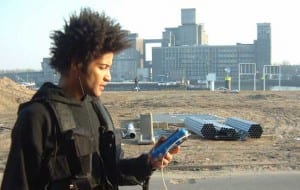Blast Theory is a performance group which creates ‘ground breaking new forms of performance and interactive art that mixes audiences across the internet, live performance and digital broadcasting’ (http://www.blasttheory.co.uk/bt/about.html, 2012). The Blast Theory Group is led by Ju Row Farr and Nick Tandavanitj, who explore uprising issues which are relevant to our society. These are expressed through different forms of media. ‘It confronts a media saturated world in which popular culture rules, using performance, installation, video, mobile and online technologies to ask questions about the ideologies present in the information that envelops us’ (http://www.blasttheory.co.uk/bt/about.html, 2012). This type of performance deemed successful amongst spectators as relatable issues were used and audience participation was gained through certain pieces. The group strives off performances which hold a risk element. ‘The group recognises that true innovation requires significant risks and it continues to be agile and highly responsive to new ideas and opportunities’(http://www.blasttheory.co.uk/bt/about.html, 2012). These risks can become introduced from the audience participation during certain performances.
Our group specifically researched the Blast Theory’s performance of Can You See Me Now?(2001) , which held spectator participation. ‘Blast Theory are fascinated by the penetration of the mobile phone into the hands of poorer users, rural users, teenagers and other demographics usually excluded from new technologies’(http://www.blasttheory.co.uk/bt/about.html, 2012). Can You See Me Now? Is performance which involves spectators being invited to play a game of hide and seek within a city centre. Although, this hide and seek game involves technologies of a satellite tracking system. The Blast Theory describe the spectators as virtual avatars. Therefore, within the game of ‘hide and seek’ the audience members split into pairs and one person from each pair needed to guide the other member around the city. Each pair were set the task of hiding from Blast Theory members within the town, which one member of the pair could see on the satellite tracking system. This performance provided audience participation ‘as a subject matter and as a medium for human interaction’(Allian 2006, P. 166). Paul Allian describes the performance ‘a sort of interactive online game that also deployed satellite tracking’(2006, P. 166). This helped the audience become more involved as the piece set out a task for spectators to complete. However, ‘the full impact of the internet on and within the performance has scarcely been felt yet, but is clearly suggests a range of practically possibilities’ (Allian 2006, P. 166). The internet was used to help guide each pair around the city, although it was not suggested as the main intention for each piece. This type of performance has not fully recognised as its own genre, ‘internet performance’ offers an interesting corollary to the recent growing interest in the embodied nature of performance’(Allian 2006, P. 166) Internet usage has risen through society, and this performance helps represent how reliant people have become on technologies within a daily routine. For our performance, we reflected Blast Theory in terms of audience participation and the use of technologies within a piece. As our performance was reliant on audience participation, which was shown through a performance exhibition, we decided to reflect the importance of a spectator lead piece. Within Blast Theory’s Can You See Me Now? Each performance was different as spectators had their own choices of hiding places and route around the city. This creates a personal type of performance, as each performance would be different in terms of spectator leadership of game. We felt that this was relevant to our performance as we knew that each time we performed the piece the audience participation would be different. We also reflected Blast Theory’s element of risk, as we knew that basing a performance around spectators without having them in the rehearsal process, may gain a risk element as they may not react how we would like them to. Our biggest problem was estimating how the spectators would move around the space. Within Blast Theory’s Can You See Me Now? the spectators were able to guide themselves through the city space. Within our performance, we needed the spectators to guide themselves into the next performance area. To overcome this problem, we decided to make Jamie (the administrator) an usher after each scene to move the audience along. Like Blast Theory, we felt that our performance needed vital planning for every problem which could occur with audience participation within our piece. Therefore, we would be prepared if something went wrong.
Another performance that we reflected from Blast Theory is Kidnap (1998), this involved The Blast Theory Group organising a kidnapping with spectators. The audience members applied to take part within this performance but were unaware of when the performance was going to take place. With this in mind, the Blast theory performance group approached the spectators from their normal daily routine and kidnapped them to form their performance. This performance ‘tackled themes of violence, pornography and politics. The group has made major innovations in its use of technology, in its working methods, and in its business model’(http://www.blasttheory.co.uk/bt/about.html, 2012). Although these issues were raised within the performance, spectators were un-aware of what was involved when signing up to participate. The performance was available to watch from the internet, where anyone viewing the piece was able to control the viewing camera’s around the hostage space and ask questions to the captured people. This performance also held the risk element as spectators were kidnapped into a hostage environment, where they were directed by the Blast Theory performers. Therefore, the Blast Theory group were unsure how participants were going to react to this uneasy situation.
Altogether, the Blast Theory group was an influence to our piece as each of their performances merged art and life into one. The company taught us the importance of gaining risk with audience participation and the relevance for preparing for unlikely audience reactions. The group helped us to understand the importance of improvisation, as until the spectators enter the space, we become unsure of how to they are going to react to the situations performed. This helped us to prepare as we participated in our own improvisation workshops to help think quickly in unlikely situations. Lastly, the Blast Theory Group used technologies from everyday life to form a performance. This helped with our stimulus as we based our performance around social networking, which is a current society debate over the dangers of speaking to the unknown. Therefore, we performed issues which were appropriate to our target audience. Altogether, the Blast Theory group helped us to gain knowledge in audience participation performance, and how internet sources can be a basis for a piece.
(http://www.blasttheory.co.uk/bt/about.html, 2012). ( Accessed: 13/5/2012)
Allian,P (2006) The Routledge Companion to Theatre and Performance, Oxon, Routledge.
By Christie Asplin.

